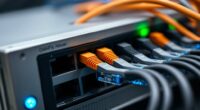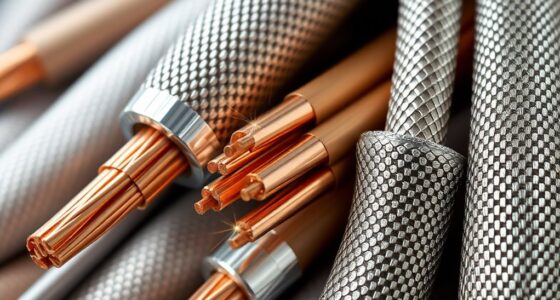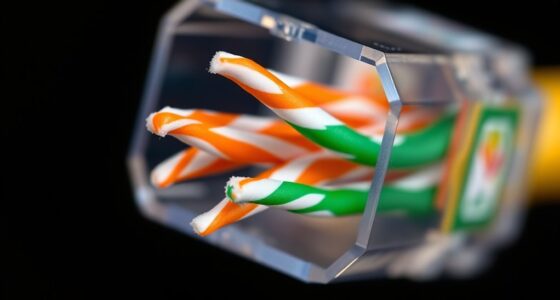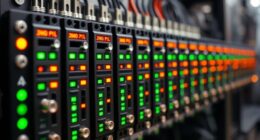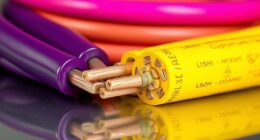Shielded twisted pair (STP) cables provide better protection against electromagnetic interference and noise, making them ideal for noisy environments like factories or high-electrical setups. Unshielded twisted pair (UTP) cables are more flexible, easier to install, and suitable for controlled settings. Shielding materials like foil or braid improve durability and signal quality, but can be stiffer. To learn more about the differences and best uses, keep exploring how shielding impacts performance and installation.
Key Takeaways
- Shielded twisted pair (STP) cables offer better electromagnetic interference (EMI) resistance than unshielded twisted pair (UTP) cables.
- UTP cables are more flexible, easier to install, and have a cleaner appearance compared to the stiffer shielded cables.
- Shielded cables provide enhanced signal integrity and are suitable for electrically noisy environments.
- UTP cables are generally more cost-effective and suitable for low-interference, controlled environments.
- Proper grounding and shielding techniques are critical for maximizing the performance of shielded cables.
Overview of Twisted Pair Cables
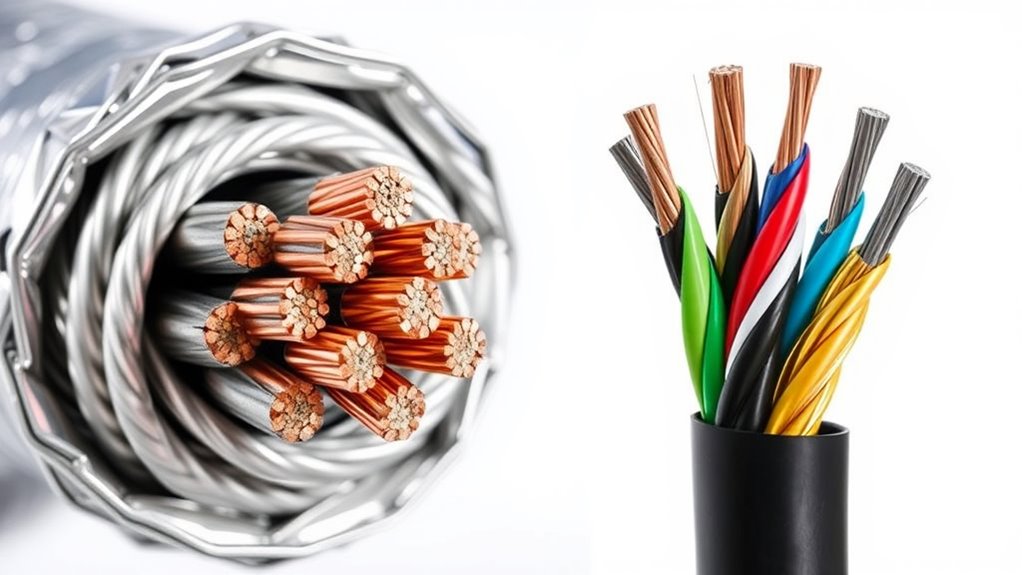
Twisted pair cables are a common type of wiring used for transmitting data and voice signals in networking and telecommunications. They consist of pairs of insulated copper wires twisted together, which helps reduce electromagnetic interference and improve electromagnetic compatibility. This design also aids in ground loop mitigation by minimizing potential differences that can cause noise or signal degradation. Additionally, eco-friendly cable options are becoming more popular as the industry emphasizes sustainability and environmentally conscious manufacturing practices. Twisted pair cables are versatile and cost-effective, making them popular for local area networks and telephone systems. While unshielded versions rely on twisting to reduce interference, shielded twisted pair cables add a protective layer to further enhance performance, especially in electrically noisy environments. Understanding these fundamentals helps you choose the right cable type for your specific networking needs, especially as AI security concerns prompt more rigorous testing and validation of network infrastructure. Furthermore, advancements in shielding techniques have significantly improved the durability and interference resistance of shielded twisted pair cables, ensuring reliable data transmission in challenging environments.
Construction and Design Differences

The primary difference in construction between shielded and unshielded twisted pair cables lies in their protective layers. Shielded cables feature an outer metallic shield or foil that encases the twisted pairs, providing added protection against electromagnetic interference. This shield can slightly reduce cable flexibility, making it a bit stiffer than unshielded options. In contrast, unshielded twisted pair cables lack this metallic layer, resulting in greater flexibility and easier installation in tight spaces. When considering aesthetic design, shielded cables often have a more industrial appearance due to their metallic shielding, while unshielded cables tend to look cleaner and more streamlined. Your choice depends on your environment and installation needs, balancing protection and ease of handling. Material properties also influence the durability and performance of these cables under various conditions. Additionally, installation considerations play a crucial role in determining which type of cable is most suitable for specific environments. Proper understanding of these differences ensures optimal performance and longevity of the cabling system. Moreover, selecting the appropriate cable type can significantly impact overall network reliability and maintenance requirements.
Interference and Noise Resistance
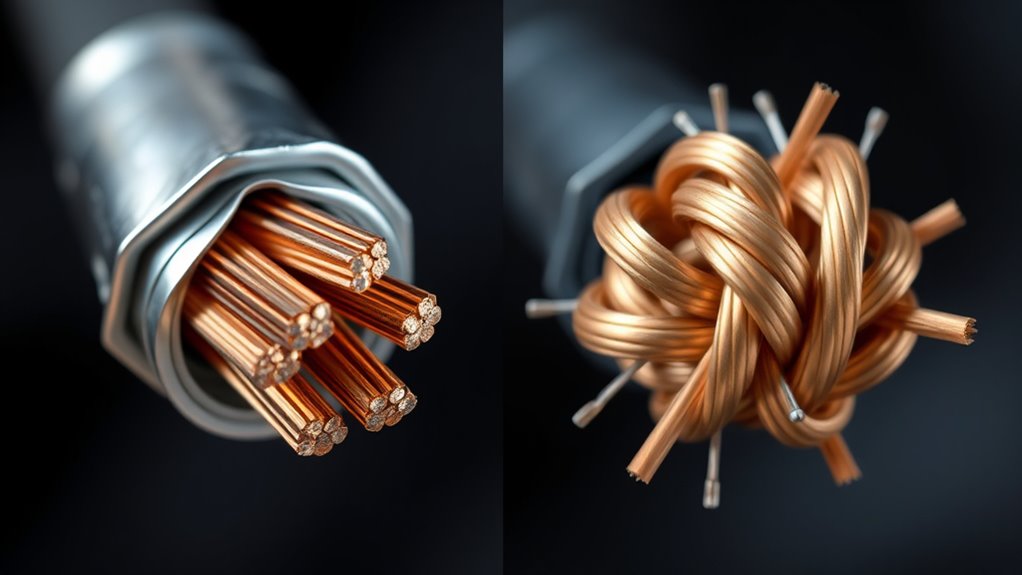
Shielded twisted pair cables excel at resisting electromagnetic interference and noise, making them ideal for environments with high electrical activity. The shielding reduces external electromagnetic fields that can disrupt signals, ensuring clearer data transmission. Additionally, shielded cables help with ground loop mitigation by preventing unwanted current paths that cause hum and noise. This enhances electromagnetic compatibility, allowing your equipment to operate smoothly without interference from nearby devices. By minimizing external noise sources, shielded cables maintain signal integrity over longer distances and in complex setups. This resistance to interference is especially critical in sensitive applications like audio, video, and data centers. Overall, shielded twisted pair cables provide a reliable solution for environments where electromagnetic interference could compromise performance. Proper shielding further enhances protection by blocking a wider range of interference types. In fact, ground loop mitigation capabilities are crucial for maintaining consistent performance in electrically noisy environments. Proper shielding can also help improve signal quality and reduce data errors, making it essential in high-precision applications. Moreover, advanced shielding techniques can also assist in thermal management, preventing overheating and ensuring consistent performance.
Shielding Materials and Methods
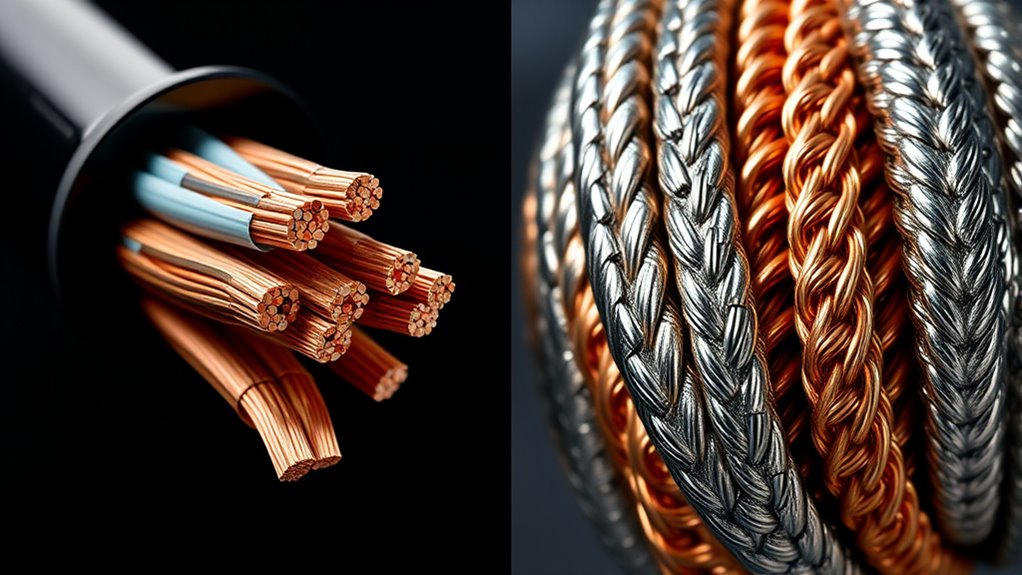
There are different shielding types you can choose from to protect your cables, each offering varying levels of interference resistance. Common shielding materials include foil, braid, and a combination of both, which are selected based on your specific needs. Understanding these materials and methods helps you decide which shielding approach is best for your environment. Additionally, considering vetted products can ensure you select safe and effective shielding options suitable for sensitive applications. Recognizing the importance of industry standards can also guide you toward choosing reliable and compliant shielding solutions. Familiarity with shielding effectiveness can help optimize your cable performance in electromagnetic environments.
Shielding Types Overview
Different shielding materials and methods are used to protect twisted pair cables from external interference, ensuring signal integrity. Shielding types vary based on their construction and grounding techniques, which influence electromagnetic compatibility. Some shields are foil, offering lightweight, flexible protection, while others are braided, providing durability and better noise reduction. Combining these methods creates overall shielding effectiveness. Proper grounding is essential to prevent interference from affecting signal quality. For instance, a shield grounded at one end reduces electromagnetic interference, while grounding at both ends minimizes noise coupling. Additionally, employing grounding techniques can further enhance noise immunity and overall performance. Understanding these shielding types helps you choose the right cable for your environment, especially when minimizing external noise is critical. Moreover, selecting the appropriate shielding method can be influenced by the cable’s intended environment, ensuring optimal performance. Considering the electromagnetic interference (EMI) in your area can help determine the most suitable shielding type for your needs.
Common Shielding Materials
Selecting the right shielding material for twisted pair cables depends on the environment and the level of interference you need to block. Common shielding materials include foil, braided copper, and combinations like foil-braid, each offering different levels of protection. Foil shields provide a lightweight barrier ideal for high-frequency interference, while braided copper offers durability and better grounding. For environments with significant electromagnetic interference, foil-braid shields are preferable. Keep in mind that fiber optic cables and wireless alternatives are increasing in popularity, often reducing the need for heavy shielding. However, when using twisted pair cables, choosing the appropriate shielding material guarantees signal integrity and minimizes crosstalk. Additionally, understanding shielding effectiveness helps in selecting the most suitable protection method for specific applications. Considering AI advancements can also influence the choice of shielding, especially in high-tech environments. Moreover, selecting the appropriate shielding material can depend on cost considerations, which vary based on the material and application requirements. An awareness of Glycolic Acid Benefits for Skin can also be helpful when selecting materials that are environmentally friendly and safe for use in various settings.
Performance in Different Environments

When choosing between shielded and unshielded twisted pair cables, you need to contemplate how they perform in various environments. Factors like interference resistance, environmental durability, and signal integrity can notably impact your network’s reliability. Understanding these differences helps you select the right cable for your specific conditions.
Interference Resistance Levels
Shielded twisted pair (STP) cables generally offer higher resistance to electromagnetic interference (EMI) compared to unshielded twisted pair (UTP) cables. This enhanced interference resistance depends heavily on proper grounding techniques, which help dissipate EMI and improve electromagnetic compatibility. When you use shielding effectively, it minimizes noise and signal degradation in environments with strong electromagnetic sources. STP cables excel in settings with high interference, such as factories or areas with heavy electrical equipment. UTP cables, lacking shielding, are more vulnerable to EMI but can still perform well with proper grounding and in low-interference environments. Your choice should consider the environment’s interference levels and the grounding methods available to guarantee peak performance and electromagnetic compatibility. Additionally, implementing proper grounding techniques can significantly enhance the effectiveness of shielded cables in high-interference settings. Proper installation practices, including shielding continuity, are essential to maximize EMI protection and ensure reliable data transmission.
Environmental Durability Factors
Environmental conditions considerably influence the performance and durability of twisted pair cables. Exposure to moisture, extreme temperatures, and physical stress can degrade cable integrity over time. Shielded cables excel in harsh environments by providing better ground loop mitigation, which reduces noise caused by grounding issues. They also enhance electromagnetic compatibility, limiting interference from external sources and preventing emissions that could affect nearby equipment. Unshielded cables, while more vulnerable to environmental factors, can still perform well in controlled settings but may require additional protection in challenging environments. Proper installation, including sealing connectors and using protective conduits, further boosts durability. Ultimately, choosing between shielded and unshielded cables depends on evaluating environmental risks and ensuring long-term reliability in diverse conditions.
Signal Integrity Variations
Signal integrity in twisted pair cables varies markedly across different environments, affecting data transmission quality and reliability. In noisy settings, unshielded cables are more vulnerable to interference, leading to potential data errors. Shielded cables help mitigate ground loop issues and improve electromagnetic compatibility, ensuring cleaner signals. Environmental factors like high electromagnetic interference (EMI) or ground potential differences can degrade performance substantially. To optimize signal integrity, consider these points:
- Shielded cables reduce susceptibility to external noise.
- Proper grounding minimizes ground loop issues.
- Environments with high EMI benefit from shielding.
- Unshielded cables may struggle in electrically noisy areas.
- Shielding enhances electromagnetic compatibility for stable data flow.
Choosing the right cable depends on your environment’s interference levels and grounding conditions, impacting overall connection reliability.
Installation Considerations

Choosing the right installation approach is crucial to guarantee peak performance and longevity of twisted pair cables. Proper grounding techniques are essential, especially for shielded cables, to prevent electromagnetic interference and ensure safety. When installing, keep cables away from sources of electrical noise, such as fluorescent lights or motors, to maintain signal integrity. Always follow installation safety guidelines, such as avoiding sharp bends and securing cables properly to prevent damage. For shielded cables, ensure the shielding is correctly grounded at both ends to maximize protection. Use appropriate tools and protective gear during installation to minimize risks. Careful planning and adherence to these considerations help prevent issues like signal degradation or interference, ensuring your network remains reliable and efficient over time.
Cost Implications

While shielded twisted pair (STP) cables often cost more upfront, they can lead to savings over time by reducing the need for additional noise mitigation measures and maintenance. When considering cost comparison, you should evaluate both initial expenses and long-term benefits. Shielded cables typically have higher purchase prices due to their protective layers, which increase material and manufacturing costs. However, they can lower expenses related to troubleshooting, repairs, and signal interference issues.
- Lower ongoing maintenance costs
- Reduced need for external noise filters
- Fewer disruptions due to interference
- Decreased downtime and troubleshooting time
- Better fit for budget considerations when long-term savings matter
Balancing these factors helps you make an informed decision aligned with your budget.
Common Applications and Use Cases

Shielded twisted pair (STP) cables are commonly used in environments where interference from electromagnetic noise is a concern, such as data centers, industrial facilities, and medical settings. They guarantee EMC compliance by reducing electromagnetic interference, which is critical in sensitive areas. You’ll find STP cables ideal when reliable data transmission is essential, especially in high-interference environments. Their shielding provides added protection against crosstalk and external noise, making them suitable for long-distance runs and high-bandwidth applications. Although installation may require more effort due to shielding, the improved performance justifies it. You can use STP cables when maintaining signal integrity is a priority, and you need a solution that offers both effective noise mitigation and reasonable installation flexibility. This makes them a preferred choice for demanding technical environments.
Future Trends in Networking Cables

As networking technology continues to evolve, future trends in cables focus on increasing speed, flexibility, and sustainability. You’ll see a shift toward fiber optic solutions that offer higher bandwidth and lower latency, supporting the growing demand for data-intensive applications. Wireless connectivity will also play a bigger role, reducing reliance on physical cables altogether. To stay ahead, expect innovations like:
- Enhanced fiber optic cables with greater durability
- Flexible, lightweight cables for easier installation
- Eco-friendly materials reducing environmental impact
- Integration of power over Ethernet (PoE) for simplified setups
- Compatibility with 5G and upcoming wireless standards
These advancements aim to provide faster, more reliable connections while embracing sustainability and seamless wireless integration for future networks.
Frequently Asked Questions
How Does Shielding Affect Cable Flexibility and Bend Radius?
Shielding in cables tends to reduce flexibility and can impose bend radius limitations because the protective layer adds stiffness. You might find that shielded cables are less flexible, making installation more challenging in tight spaces. While shielding offers better protection against interference, it creates a trade-off by decreasing bend radius. So, when choosing a cable, consider your flexibility needs versus the level of shielding required for your environment.
Can Shielded Cables Be Used in Outdoor Environments Without Additional Protection?
Yes, shielded cables can be used outdoors without extra protection if they’re designed for outdoor durability. Look for cables with corrosion-resistant jackets and UV protection, which help withstand environmental elements. These features guarantee your shielded cables handle exposure to moisture, sunlight, and temperature changes effectively. However, for long-term outdoor use, it’s often best to verify the manufacturer’s specifications to ensure maximum corrosion resistance and durability.
What Are the Environmental Impacts of Different Shielding Materials?
Ever wondered how shielding materials impact our environment? You should know that some, like aluminum and copper, have sustainability issues due to resource extraction and energy use. Others, like polyethylene, can degrade over time, causing environmental degradation effects. Choosing eco-friendly shielding materials minimizes negative environmental impacts, promotes sustainability, and reduces long-term waste. By prioritizing environmentally conscious options, you help lessen pollution and conserve resources for future generations.
How Do Shielded Cables Affect Network Latency and Signal Latency?
Shielded cables reduce electromagnetic interference, which helps maintain signal quality and minimizes latency. Because they better protect against external noise, your network experiences less signal attenuation, resulting in faster data transmission. However, the additional shielding can add slight delays due to increased cable thickness and potential grounding issues. Overall, shielded cables improve network performance by decreasing interference-related latency, especially in noisy environments, ensuring your signals stay clear and fast.
Are There Any Specific Safety Standards for Shielded Versus Unshielded Cables?
Think of shielded cables as knights guarding your data against electromagnetic interference, and unshielded cables as open battlegrounds. Shielded cables often meet strict safety certifications like UL or CE, ensuring they’re safe for use and reduce electromagnetic interference risks. These standards verify that the cables won’t pose safety hazards, making shielded options preferable in environments with high interference. Always check for appropriate safety certification to keep your network safe and compliant.
Conclusion
As you consider your options between shielded and unshielded twisted pair cables, remember that the choice isn’t just about cost or ease of installation. It’s about how much interference you’re willing to risk and what your network truly demands. Will the environment’s noise levels push you toward shielding, or can you rely on unshielded cables? The decision you make now could shape your network’s performance in ways you might not fully anticipate—until it’s too late.

